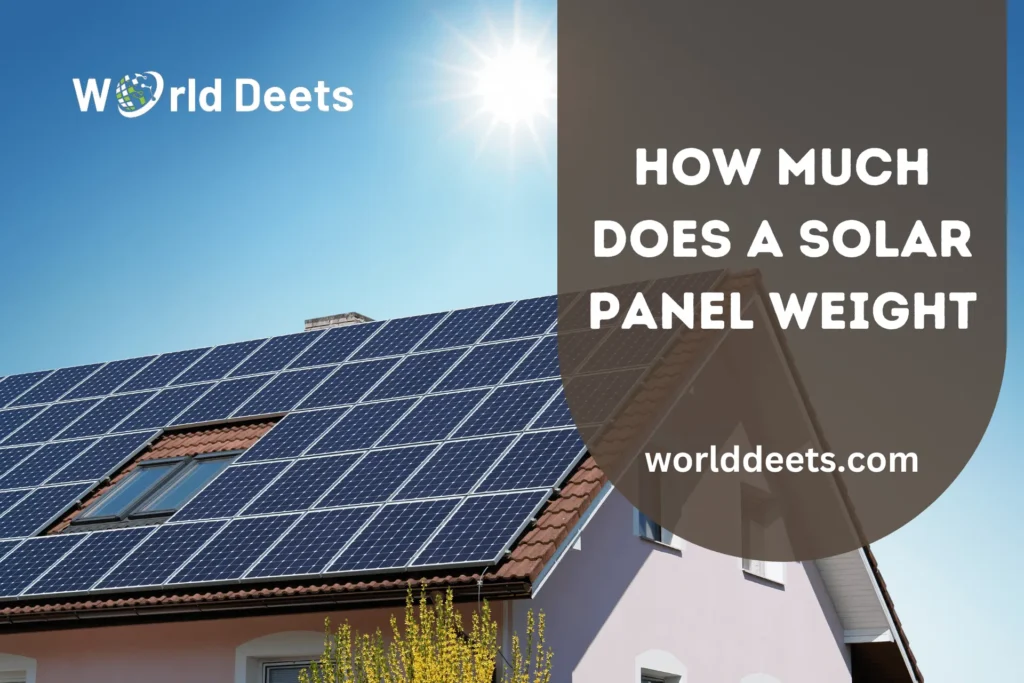How much does a solar panel weight | Understanding the Basics

Solar panels, which are commonplace on rooftops and in landscapes all over the world, have become synonymous with environmentally friendly energy sources. As individuals and businesses alike increasingly embrace solar power, one common question prevails: How much does a solar panel weight? In this detailed exploration, we’ll delve into the intricacies of solar panel weight, covering different types, factors influencing weight, and the importance of this metric in solar installations.
The Varied World of Solar Panels
There is a wide variety of solar panels available, each of which has its own set of qualities and sets of applications. To make educated selections regarding installations, it is essential to have a solid understanding of their distinctions.
Traditional Photovoltaic Panels
Traditional solar panels, which are sometimes referred to as photovoltaic panels, are a common sight on both residential and business sites. The majority of these panels are constructed out of crystalline silicon, and they are available in two primary varieties: monocrystalline and polycrystalline. In general, the weight of these panels varies between 40 to 50 pounds (18 to 23 kg). The weight can vary based on factors like size, wattage, and the materials used in manufacturing.
Thin-Film Solar Panels
In contrast to the rigidity of traditional panels, thin-film solar technology has introduced a more lightweight and flexible alternative. These panels utilize layers of semiconductor materials and are known for their versatility. Weighing significantly less than their crystalline counterparts, thin-film solar panels typically range from 10 to 20 pounds (4.5 to 9 kilograms), making them a favorable option for specific applications.
Bifacial Solar Panels
Bifacial solar panels represent an innovation that has transformed the solar energy landscape. Because of its design, these panels can collect sunlight from both the front and the back, greatly boosting their energy yield. The weight of bifacial panels aligns with traditional ones, but the enhanced efficiency makes them an attractive choice for installations in diverse environments.
Factors Influencing Solar Panel Weight
The weight of a solar panel is influenced by various factors, ranging from its size and wattage to the materials used in its construction.
Panel Size and Wattage
The weight of a solar panel is mostly determined by its size and wattage. Larger panels with higher wattage typically contain more materials, contributing to increased weight. Consumers and installers need to consider the dimensions and power output of the panels, balancing energy production goals with structural considerations.
- Frame Material
A solar panel’s frame, which is often composed of steel or aluminum, offers structural stability and security. The panel’s total weight may vary depending on the type of frame material selected. Because they are corrosion-resistant and lightweight, aluminum frames are a common option for home installations. In contrast, steel frames, while heavier, may be preferred for certain commercial or industrial applications where durability is paramount. - Thnological Advancements
Advancements in solar technology are not only enhancing energy efficiency but also influencing the weight of solar panels. The production of solar panels with higher energy generation per unit area is made possible by the advancement of high-efficiency solar cells, which may result in a reduction of the total number of panels needed for a given installation.
Understanding the Importance of Solar Panel Weight
The weight of solar panels is a crucial consideration in various aspects of their lifecycle, from installation to transportation and maintenance.
Rooftop Installations
For residential and commercial rooftop installations, the weight of solar panels is a critical consideration. The additional weight of the panels must not compromise the building’s structural stability. Installers and engineers conduct thorough assessments to ensure that the roof can accommodate the weight of the solar array without compromising safety.
Transportation and Handling
Solar panels are transported from manufacturing facilities to installation sites, necessitating careful consideration of their weight. Heavier panels may require specialized handling equipment and incur higher transportation costs. Understanding the weight of solar panels is integral to logistical planning and ensuring a smooth installation process.
A Comparative Overview of Solar Panel Weights
Here is a table that summarizes the typical weights of the various kinds of solar panels for easy reference.
| Solar Panel Type | Average Weight Range | Characteristics |
| Traditional (Crystalline) | 40 to 50 lbs (18 to 23 kg) | Made of crystalline silicon, common for residential use. |
| Thin-Film | 10 to 20 lbs (4.5 to 9 kg) | Lightweight and flexible, suitable for specific applications. |
| Bifacial | 40 to 50 lbs (18 to 23 kg) | Captures sunlight from both front and rear sides, enhancing efficiency. |
Future Trends in Solar Panel Weight
Exploring ongoing research and emerging technologies that could shape the weight dynamics of solar panels in the future.
Perovskite Solar Cells
The emergence of perovskite solar cells represents a potential game-changer in the solar industry. These unique material-based cells have the potential to outperform conventional silicon-based cells in terms of weight and efficiency. While still in the research and development stage, perovskite solar cells could revolutionize the weight dynamics of solar panels in the future.
Continual Material Innovations
To lighten solar panels without sacrificing performance, researchers are always looking into novel materials and production processes. Lightweight and durable materials, combined with novel construction methods, could pave the way for even more versatile and efficient solar solutions.
Striking the Balance in Solar Panel Weight
As the world turns toward renewable energy, understanding the weight of solar panels is pivotal for successful and sustainable installations. Whether considering traditional crystalline panels, lightweight thin-film alternatives, or innovative bifacial options, the interplay of factors influencing weight underscores the complexity of solar technology. As advancements continue and the industry evolves, the quest for lighter, more efficient solar panels will undoubtedly shape the future of solar energy production.
Wrapping Up
In this blog how much does a solar panel weight closing, the weight of a solar panel is not merely a numerical metric but a critical factor influencing where and how we harness the sun’s power. It is a delicate balance between efficiency, structural considerations, and environmental impact, all contributing to a cleaner and more sustainable energy landscape.






